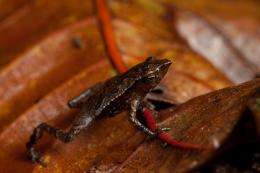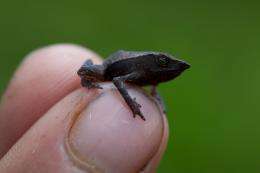Three new amphibian treasures found on search for 'lost' frogs

A team of scientists on a quest to rediscover several "lost" amphibians in western Colombia has returned with a surprising result: three species of frogs believed to be entirely new to science, Conservation International (CI), the IUCN Amphibian Specialist Group (ASG), Global Wildlife Conservation (GWC) and Fundación ProAves announced today.
Among the discoveries are a mysterious toad with ruby-colored eyes, a diminutive long-nosed beaked toad which hides in dead leaves, and a gorgeous new rocket frog with flashes of red on its legs. All three species were found during the day when they were most active, a behavior which scientists say is unusual among most amphibians.
The scientific expedition, led by CI's Amphibian Conservation Specialist Dr. Robin Moore, Dr. Don Church of GWC, and Colombian scientist Alonso Quevedo of Fundación ProAves, took place this past September in Colombia to search for the long lost Mesopotamia beaked toad, which hasn't been seen since the outbreak of World War I, and is described as Critically Endangered by the IUCN Red List of Threatened Species.

Despite a week of intensive field study scouring habitats from chilly cloud forests to steamy lowland rainforests in Colombia's Chocó and Antioquia departments, the lost species eluded the team.
"After spending several days searching for the Mesopotamia beaked toad with no success, the team's spirits were pretty low" said Moore, who has organized the Search for Lost Frogs for CI and the ASG, "but finding these new species, including a new beaked toad, was like a shot of adrenaline. We definitely left on a high."
Dr. Moore added, "Finding three new species in such a short space of time speaks to the incredibly rich biodiversity of these relatively unexplored forests and highlights their importance for conservation. Protecting these habitats into the future will be essential to ensure the survival of both the amphibians and the benefits that they bring to ecosystems and people."
The newly discovered amphibians are:
New species of beaked toad – genus Rhinella, found in the rainforests of Chocó department of Colombia, during the "Search for Lost Frogs". In addition to its strange appearance, the beaked toad is rather unusual in that it probably skips the tadpole stage, laying eggs on the forest floor that hatch directly into toadlets. The coloration and shape of the head make the toad resemble the dead leaves on which it lives, and the only two individuals found were no larger than 2cm in length.
New toad species – genus undetermined; found on the forest floor, this toad is about 3-4cm in length, with striking bright red eyes. This highly unusual species has scientists baffled – they know nothing about this species other than where it lives, which is around 2,000m elevation in the Chocó montane rainforest. Scientists trekked up very steep slopes to reach the habitat where they found the new toad.
New species of rocket frog – genus Silverstoneia; a type of poison dart frog - a group that has given rise to many chemicals found to be useful to humans - this species is less poisonous than its brightly colored relatives. Living in and around streams, the rocket frogs carefully carry newly hatched tadpoles on their backs to deposit them in water to complete their development. This is a small species, which probably does not grow larger than 3cm in total length.
In describing the new mystery toad, Dr. Moore said, "I have never seen a toad with such vibrant red eyes. This trait is highly unusual for amphibians, and its discovery offers us a terrific opportunity to learn more about how and why it adapted this way."
"As for the new beaked toad, it is easily one of the strangest amphibians I have ever seen. Its long pointy snout-liked nose reminds me of the nefarious villain, Mr. Burns, from The Simpsons television series."
After seeing pictures of the new species, Simpsons series long time writer/producer and amphibian enthusiast, George Meyer said of the resemblance, "The toad's imperious profile and squinty eyes indeed look like Monty Burns." Meyer is an active member of Conservation International's Chairman's Council.
The unprecedented search, which is taking place in 19 countries on five continents, has led to three species rediscoveries in the past few months, including: a Mexican salamander not seen since it was discovered in 1941, a frog from the Ivory Coast not seen since 1967 and another frog from Democratic Republic of Congo not seen since 1979.
It marks the first ever coordinated effort to find such a large number of "lost" creatures and comes as global amphibian populations are suffering a shocking decline - with more than 30 per cent of all species threatened with extinction. Many of the amphibians that the teams of scientists have been looking for have not been seen in several decades, and establishing whether populations have survived or not is vital for scientists looking to understand the recent amphibian extinction crisis.
Driving the search is the important role that amphibians play in healthy ecosystems and the services they provide to people, such as controlling insects that spread disease and damage crops, helping to maintain healthy freshwater systems, and fueling the development of new drugs with the potential to save lives.
"They are like a vital organ pumping life into these forests", Moore said, "ensuring clean fresh water for local communities, in addition to holding untold potential medicinal properties. For example, the rocket frog belongs to the same family as poison dart frogs, well known for their skin secretions: a substance isolated from the skin of the phantasmal poison frog of Ecuador produces a painkiller 200 times more potent than morphine."
The first phase of the Search for the Lost Frogs campaign will continue through the end of 2010, with further rediscoveries expected this year. The search for the Mesopotamia beaked toad also continues. Thanks to support from the U.S. Fish and Wildlife Service, the four organizations involved in the Colombian search have hired a team of young researchers to explore the mountains of Colombia in search of this and other lost species.
Provided by Conservation International
















